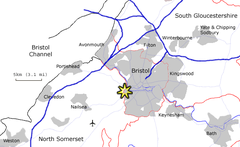Ashton Court
| Ashton Court | |
|---|---|
 |
|
| General information | |
| Architectural style | Mixed |
| Town or city | Bristol |
| Country | England |
| Coordinates | 51°26′52″N 2°38′41″W / 51.4479°N 2.6446°WCoordinates: 51°26′52″N 2°38′41″W / 51.4479°N 2.6446°W |
| Construction started | 1633 |
| Client | Smyth family |
Ashton Court is a mansion house and estate to the west of Bristol in England. Although the estate lies mainly in North Somerset, it is owned by the City of Bristol. The mansion and stables are a Grade I listed building. Other structures on the estate are also listed.
Ashton Court has been the site of a manor house since the 11th century, and has been developed by a series of owners since then. From the 16th to 20th centuries it was owned by the Smyth family with each generation changing the house. Designs by Humphry Repton were used for the landscaping in the early 19th century. It was used as a military hospital in the First World War. In 1936 it was used as the venue for the Royal Show and, during the Second World War as an army transit camp. In 1946 the last of the Smyth family died and the house fell into disrepair before its purchase in 1959 by Bristol City Council.
The estate developed from the original deer park and is Grade II* listed on the Register of Historic Parks and Gardens of special historic interest in England. It is the venue for a variety of leisure activities, including the now-defunct Ashton Court Festival, Bristol International Kite Festival and the Bristol International Balloon Fiesta. It is home to charity The Forest of Avon Trust.
Ashton Court dates back to before the 11th century. It is believed that a fortified manor stood on the site, given to Geoffrey de Montbray, Bishop of Coutances, by William the Conqueror. In the Domesday Book it is referred to as a wealthy estate owned by the Bishop of Countances, with a manor house, a great hall, and courtyards entered through gatehouses. The property passed through successive owners and at the end of the 14th century it was considerably expanded when Thomas De Lions, a nobleman originally from France, obtained a permit to enclose a park for his manor. The house was owned by the Choke family for some time. In 1506 it was sold to Sir Giles Daubeney, a knight and a Chamberlain of Henry VII. Henry VIII gave the estate to Sir Thomas Arundel in 1541 and four years later in 1545 Sir Thomas sold it to John Smyth. The Smyth family owned the property for the next 400 years. Smyth also bought the land which had been owned, until the Dissolution of the Monasteries, by Bath Abbey. He used the land to extend the deer park, bringing him into conflict with the residents of Whitchurch, who complained that he had used common land.
...
Wikipedia


